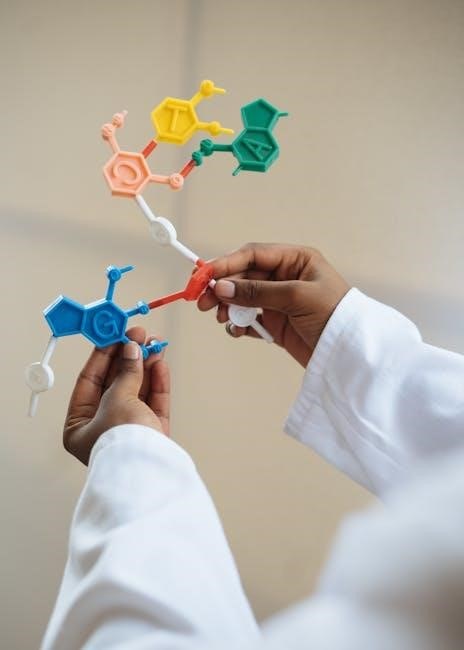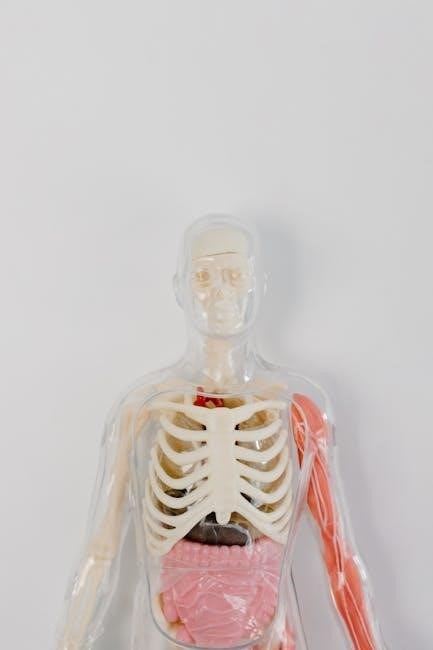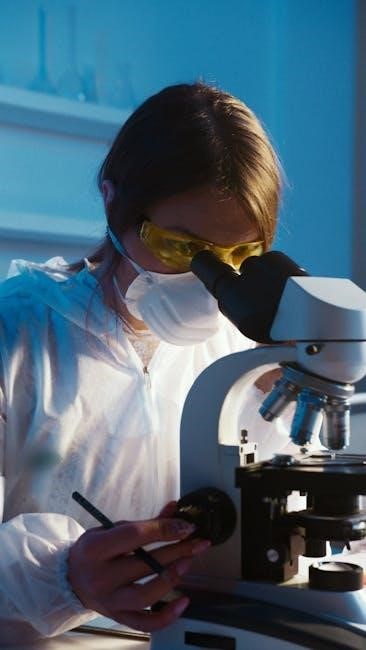The mole is the fundamental unit of amount of substance in chemistry, defined by Avogadro’s number (6.022 x 10²³ particles). It enables chemists to quantify substances accurately, making it essential for calculations, chemical equations, and stoichiometry. Understanding moles is crucial for solving problems involving mass, volume, and concentration in GCSE Chemistry.
1.1 What Are Moles?
The mole (mol) is the SI unit for amount of substance, representing 6.022 x 10²³ particles (Avogadro’s number). It connects the microscopic (particles) to the macroscopic (mass and volume). Moles allow chemists to calculate quantities like mass (using molar mass) and volume (using concentration). For example, one mole of carbon atoms weighs 12 grams. Understanding moles is vital for chemical calculations, stoichiometry, and solution preparation. The formula ( n = rac{m}{M} ) links moles (n), mass (m), and molar mass (M). This concept is foundational in GCSE Chemistry for solving problems and analyzing reactions.
1.2 Importance of Moles in Chemistry
Moles are central to chemistry as they standardize the measurement of substances. They allow chemists to determine the number of particles in a sample, calculate concentrations, and predict reaction outcomes. Moles simplify comparisons between substances by relating mass and volume to particle count. This is crucial for chemical reactions, as stoichiometry relies on mole ratios. In GCSE Chemistry, mastering moles is essential for solving problems, balancing equations, and understanding laboratory processes. Accurate mole calculations ensure precise results in experiments and industrial applications, making them a cornerstone of chemical literacy.
1.3 Avogadro’s Law and Its Significance
Avogadro’s Law states that the volume of a gas is directly proportional to the number of moles of gas at constant temperature and pressure. This law underscores the relationship between macroscopic gas properties and microscopic molecular quantities. It is foundational for understanding gas behavior and calculating molar volumes. In GCSE Chemistry, Avogadro’s Law is applied to solve problems involving gas volumes and mole ratios. Its significance lies in connecting theoretical concepts to practical calculations, enabling chemists to predict and quantify gas reactions and properties accurately.

Calculations Involving Moles
Mastering mole calculations is essential in GCSE Chemistry. It involves converting between moles, mass, and volume using molar mass and concentration. Accurate calculations are vital for stoichiometry and chemical equations.
2.1 Calculating Moles from Mass
Calculating moles from mass involves using the molar mass of a substance. The formula is: moles = mass (g) / molar mass (g/mol). Molar mass is found by summing the atomic masses of all atoms in the formula. For example, to find moles of NaCl, use its molar mass (58.44 g/mol). Ensure units are consistent and calculations are precise. This skill is fundamental for solving stoichiometric problems and understanding chemical reactions in GCSE Chemistry.
2.2 Calculating Moles from Volume
Calculating moles from volume involves using the concentration of a solution. The formula is: moles = concentration (mol/dm³) × volume (dm³). For example, if a solution has a concentration of 2.0 mol/dm³ and a volume of 0.5 dm³, the moles of solute are 1.0 mol. Ensure units are consistent (convert cm³ to dm³ by dividing by 1000). This method is commonly used in titration experiments to determine the amount of a substance in a solution, making it a key skill in GCSE Chemistry practical work and problem-solving.
2.3 Converting Between Moles, Mass, and Volume
Converting between moles, mass, and volume involves using fundamental formulas. To find moles from mass: moles = mass (g) / molar mass (g/mol). To find mass from moles: mass = moles × molar mass. For volume, moles = concentration (mol/dm³) × volume (dm³). Ensure units are consistent, converting cm³ to dm³ by dividing by 1000. These conversions are essential in stoichiometry and titration calculations, allowing chemists to relate quantities of substances in different forms within GCSE Chemistry problems.

The Mole in Chemical Reactions
Converting between moles, mass, and volume requires using molar mass and concentration. Moles to mass: mass = moles × molar mass. Moles to volume: volume = moles / concentration. Ensure units match (e.g., g to kg, cm³ to dm³). These conversions are vital for solving problems involving chemical reactions, titrations, and gas calculations in GCSE Chemistry, enabling accurate quantification of substances in different forms.
3.1 Mole Ratios in Balanced Chemical Equations
Mole ratios are derived from the coefficients in balanced chemical equations, representing the relative amounts of reactants and products in moles. These ratios are essential for stoichiometric calculations, allowing chemists to determine the amount of substances involved in a reaction. For example, in the equation CH₄ + 2O₂ → CO₂ + 2H₂O, the mole ratio of methane to oxygen is 1:2. Understanding mole ratios enables accurate predictions of reactant and product amounts, crucial for laboratory experiments and industrial processes in GCSE Chemistry.
3.2 Using Moles to Determine Reactant and Product Amounts
In chemical reactions, moles are used to calculate the amounts of reactants and products using mole ratios from balanced equations. For instance, in the reaction 2H₂ + O₂ → 2H₂O, the mole ratio of H₂ to O₂ is 2:1. If you have 4 moles of H₂, you need 2 moles of O₂. To find the mass, convert moles to grams using molar masses: 4 moles H₂ * 2 g/mol = 8 g H₂ and 2 moles O₂ * 32 g/mol = 64 g O₂. For products, 4 moles H₂ yield 4 moles H₂O, which is 72 g (4 moles * 18 g/mol). Always balance equations first and ensure units match to avoid errors. Limiting reagents are identified by comparing actual mole ratios to stoichiometric ratios, determining the reactant that limits product formation. Practice problems help solidify understanding of these calculations.
3.3 Limiting Reagents and Excess Reactants
Determining the limiting reagent involves comparing the mole ratio of reactants to the stoichiometric ratio in the balanced equation. For example, in 2A + B → 2C, if 4 moles of A and 3 moles of B are available, the limiting reagent is identified by dividing each reactant’s moles by their coefficients: 4/2 = 2 for A and 3/1 = 3 for B. A is the limiting reagent since it has the smaller value. This affects the theoretical yield, calculated based on the limiting reagent’s moles. Common errors include incorrect mole ratios and unit conversions. Always balance the equation first to avoid mistakes. Understanding this concept is crucial for optimizing chemical reactions and reducing waste in real-world applications.

Empirical and Molecular Formulas
Empirical formulas are determined by calculating mole ratios of elements using their masses and molar masses. Molecular formulas are derived by multiplying empirical formulas by a factor. This helps determine percentage composition and verifies chemical structures through mole-based calculations.
4.1 Determining Empirical Formulas Using Moles
Determining empirical formulas involves calculating mole ratios of elements in a compound. First, masses of each element are measured and converted to moles using their molar masses. These mole values are then divided by the smallest to find ratios. For example, if an element has 2 moles and another has 1 mole, the ratio is 2:1. This process simplifies to the simplest whole number ratio, giving the empirical formula. This method is foundational for identifying the composition of unknown compounds in chemistry.
4.2 Converting Empirical Formulas to Molecular Formulas
To convert an empirical formula to a molecular formula, the molecular mass must be known. First, calculate the empirical formula by determining mole ratios of elements. Next, divide the molecular mass by the empirical mass to find the multiplier. Multiply each element’s subscript in the empirical formula by this number to obtain the molecular formula. For example, if the empirical formula is CH₂O and the molecular mass is 180 g/mol, dividing 180 by 30 (empirical mass) gives 6. Thus, the molecular formula is C₆H₁₂O₆. This process links mole ratios to molecular structure.
4.3 Calculating Percentage Composition
Percentage composition calculates the mass percentage of each element in a compound. The formula used is:
( [ ext{mass of element} / ext{molar mass of compound} ] ) × 100.
This requires the molecular formula to determine the molar mass. Each element’s mass is found by multiplying its atomic mass by the number of atoms. Summing these gives the molar mass. Accurate atomic masses from the periodic table are essential. This skill is vital for analyzing compounds in chemistry, enabling the determination of elemental ratios in substances, which is fundamental for chemical analysis and synthesis in various fields.

Stoichiometry and Moles
Stoichiometry involves using moles to study quantitative relationships in chemical reactions. It relies on balanced equations to determine amounts of reactants and products, ensuring accurate calculations.
5.1 Defining Stoichiometry
Stoichiometry is the branch of chemistry that studies the quantitative relationships between reactants and products in chemical reactions. It is based on the law of conservation of mass, which states that matter cannot be created or destroyed in a chemical reaction. Stoichiometry involves using balanced chemical equations to determine the ratios in which substances react and produce products. These ratios are expressed in terms of moles, allowing chemists to calculate the amounts of reactants required or products formed. Accurate stoichiometric calculations are essential in various industries, including chemistry, engineering, and pharmacology, to optimize processes and ensure safety. Understanding stoichiometry is critical for solving problems in GCSE Chemistry, particularly in modules involving chemical reactions and mole concepts.
5.2 Using Moles in Stoichiometric Calculations
In stoichiometry, moles are used to calculate the amounts of reactants and products in chemical reactions. Balanced equations provide mole ratios, which are used to determine how much of each substance is needed or produced. For example, if a reaction requires 2 moles of reactant A for every 1 mole of product B, the ratios guide calculations. Molar masses and concentrations are essential for converting between moles and grams or liters. Common methods include the mole road map and conversion factors, ensuring accurate calculations. These skills are vital for solving problems in GCSE Chemistry and real-world applications like chemical engineering and pharmacy.
5.3 Real-World Applications of Stoichiometry
Stoichiometry is crucial in various industries, such as chemical manufacturing, where precise amounts of reactants are needed to produce desired products efficiently. In pharmaceuticals, it ensures the correct dosages of active ingredients. Environmental science uses stoichiometry to calculate pollution levels and treatment processes. Food production relies on it for recipe formulation and preserving nutritional content. Additionally, in energy sectors, stoichiometry optimizes fuel combustion, reducing waste and emissions. These applications highlight the practical importance of mole-based calculations, making them essential skills for GCSE Chemistry students pursuing careers in science and technology.

Common Mistakes in Mole Calculations
Common errors include using incorrect molar masses, forgetting unit conversions, and misapplying mole ratios. These mistakes can lead to incorrect results, emphasizing the need for precise calculations in GCSE Chemistry problems.
6.1 Incorrect Use of Molar Mass
Molar mass is a critical factor in mole calculations, representing the mass of one mole of a substance. A common mistake is using an incorrect molar mass, often due to adding or omitting elements in a compound’s formula. For example, confusing grams with kilograms or using the wrong relative atomic mass from the periodic table can lead to significant errors. These mistakes can propagate through calculations, affecting mole and concentration values. Ensuring accurate molar masses is essential for reliable results in GCSE Chemistry problems, emphasizing the importance of careful calculation and verification.
6.2 Forgetting to Convert Units
Forgetting to convert units is a prevalent error in mole calculations. For instance, using centimetres cubed (cm³) instead of litres or millilitres without converting can lead to incorrect molarity values. Similarly, mixing grams and kilograms without proper conversion disrupts mole-to-mass calculations. Students often overlook unit consistency, resulting in errors that affect mole counts and reaction stoichiometry. Ensuring all units align before performing calculations is vital to avoid inaccuracies. This mistake underscores the importance of careful attention to detail in chemistry problems, as incorrect units can entirely skew results and interpretations.
6.3 Misinterpreting Mole Ratios
Misinterpreting mole ratios is a common mistake in chemical calculations. Mole ratios, derived from balanced equations, indicate the relative amounts of reactants and products. Errors occur when ratios are misread or applied incorrectly. For example, confusing a 2:1 ratio with 1:2 leads to incorrect calculations of reactant or product amounts. Another mistake is using unbalanced ratios directly. Always balance the equation first and ensure the ratios align with the substances involved. Double-checking ratios before calculations helps prevent such errors, ensuring accurate stoichiometric results.

Practice Questions and Answers

Sample questions and answers cover mole calculations, balancing equations, and stoichiometry. They provide step-by-step solutions, ensuring clarity and understanding of key concepts in GCSE Chemistry.
7.1 Sample Questions on Mole Calculations
Calculate the number of moles in 25.0 g of sodium carbonate (Mr = 105.99 g/mol).
Determine the mass of 0.500 mol of calcium hydroxide (Mr = 74.09 g/mol).
A solution contains 15.0 g of sodium sulfate in 250 cm³. Calculate the concentration in mol/dm³.
How many moles are in 30.0 cm³ of a 0.200 mol/dm³ potassium nitrate solution?
If 1.20 mol of carbon dioxide reacts completely, how many moles of oxygen are produced?
These questions test understanding of mole relationships, molar mass, and concentration calculations.
7.2 Answers to Practice Questions
Moles of sodium carbonate = 25.0 g / 105.99 g/mol ≈ 0.236 mol.
Mass of calcium hydroxide = 0.500 mol × 74.09 g/mol = 37.045 g.
Moles of sodium sulfate = 15.0 g / 142.04 g/mol ≈ 0.1056 mol. Concentration = 0.1056 mol / 0.250 dm³ = 0.422 mol/dm³.
Moles of potassium nitrate = 0.200 mol/dm³ × 0.030 dm³ = 0.006 mol.
Balanced equation: 2 CO₂ → 2 CO + O₂. Moles of O₂ = 1.20 mol × (1 mol O₂ / 2 mol CO₂) = 0.600 mol.
These answers provide clear solutions to mole calculations, covering mass, volume, and concentration problems.
7.3 Tips for Solving Mole-Based Problems
Mastering mole calculations requires attention to detail and systematic approaches. Always label units and convert them appropriately. Use the molar mass from the periodic table accurately. For gases, apply Avogadro’s law when necessary. Break problems into steps: identify given values, unknowns, and required formulas. Check mole ratios in balanced equations for stoichiometry. Practice conversions between moles, mass, and volume regularly. Verify units match the required answer format. Review common mistakes to avoid errors. Timed exercises enhance speed and accuracy, ensuring readiness for exams.

Revision Strategies for Mole Concepts
Use flashcards for key terms, practice timed exercises, and organize notes effectively. Review past papers and engage in group study to clarify doubts and reinforce understanding.
8.1 Effective Note-Taking Techniques
Effective note-taking involves organizing information clearly and concisely. Use bullet points, headings, and subheadings to structure content. Highlight key terms and formulas to emphasize important concepts. Summarize complex ideas in your own words to enhance understanding. Review and revise notes regularly, ensuring accuracy and completeness. Incorporate diagrams and flowcharts to visualize relationships between concepts, such as mole calculations and chemical reactions. Utilize different colors to categorize information, making it easier to revise and recall during exams. Consistent and systematic note-taking improves retention and supports successful learning outcomes in GCSE Chemistry.
8.2 Using Flashcards for Key Terms
Flashcards are an excellent tool for memorizing key terms and concepts in GCSE Chemistry. Create flashcards with terms like “mole,” “Avogadro’s number,” and “molar mass” on one side and their definitions or applications on the other. Use different colors to categorize terms, such as green for formulas and red for important definitions. Incorporate diagrams or formulas where relevant to aid visual learners. Regularly test yourself by covering the answer side and recalling the information. This active recall strengthens memory and understanding, making revision more efficient and effective for exams.
8.3 Timed Practice Exercises
Timed practice exercises are a proven way to improve speed and accuracy in GCSE Chemistry. Set a timer for 20-30 minutes and solve mole-related problems, simulating exam conditions. Start with mixed-topic questions to apply concepts under pressure. Focus on common mistakes, such as incorrect unit conversions or molar mass errors. Review answers to identify weaknesses and revise those areas. Regular timed sessions build confidence and time management skills, ensuring readiness for the actual exam. Track progress to see improvement over time, reinforcing understanding and reducing anxiety.

The Role of Moles in Laboratory Applications
Moles are crucial in lab settings for preparing solutions, calculating concentrations, and measuring precise amounts of substances. They ensure accuracy in titrations and chemical reactions, forming the basis of experimental design and data analysis.
9.1 Preparing Solutions in the Lab
Preparing solutions in the lab involves calculating the exact amount of solute needed using moles. By determining the molar mass of the substance, the mass required to achieve a specific molarity can be calculated. This ensures precise concentrations, which are vital for accurate experimental results. For instance, to prepare a 0.5 M solution of sodium chloride, the molar mass of NaCl (58.44 g/mol) is used to find the mass needed for a given volume. This process relies heavily on mole concepts and molar calculations to maintain consistency and reliability in laboratory work.
9.2 Using Moles in Titrations
Titrations involve the reaction of an acid with a base to determine the concentration of an unknown solution. Moles are essential in calculating the exact amount of substance reacting. By determining the number of moles of the known solution (from its concentration and volume), the moles of the unknown solution can be found using stoichiometric ratios. This process relies on accurate measurements of volume using burettes and the application of mole concepts to find precise concentrations, making titrations a fundamental laboratory technique in GCSE Chemistry for determining the concentration of solutions.
9.3 Measuring Accurate Mass and Volume
Accurate measurements of mass and volume are critical in laboratory applications involving moles. Mass is typically measured using balances, while volume is measured using burettes, pipettes, or measuring cylinders. In titrations, precise volume measurements are essential to determine the concentration of solutions. Common errors include misreading instruments or not calibrating equipment properly. Understanding how to measure accurately ensures reliable data for mole calculations, such as determining the number of moles of a reactant or product in a chemical reaction. This skill is vital for experiments involving stoichiometry and solution preparation in GCSE Chemistry.
